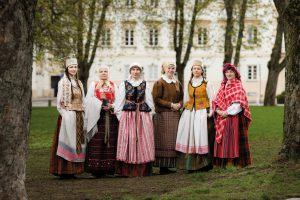Lithuanian Traditional and Folk Costumes: Textiles, Graphic Art, Painting. Exhibition
11 May – 5 November 2017

The Lithuanian Art Museum is marking the Year of the National Folk Costume with a special exhibition presenting traditional Lithuanian and national folk costumes and how they have been portrayed in the work of professional artists.
The traditional festive dress of Lithuanian peasants formed over the centuries until the mid-19th century, affected by historical and economic conditions, traditions and customs. Five ethnographic regions can be distinguished in Lithuania – Aukštaitija, Dzūkija, Suvalkija, Žemaitija and Lithuania Minor. The same components made up the traditional costumes worn by women: a shirt, skirt, vest, apron, sash, head-covering, shoes and warmer outer clothes. The clothes of women and younger girls were identical, one’s position in the family being indicated by the type of head-covering – married or mature women would wear various kinds of crocheted caps or woven veils, while younger, unmarried women and girls decorated themselves with floral wreaths, braids and various types of crowns. Both would wear head-scarves. In various ethnographic regions, also in smaller territorial units such as individual parishes, the cut and decoration of clothing, woven textile patterns and colour combinations would differ. Women sought to express their individuality through their dress, as well as their abilities and sense of aesthetics and harmony of colours.
Clothing would be sewn from textiles woven at home. In the late 18th–19th centuries, factory-woven fabrics were relatively uncommon in villages – women could buy silk and wool scarves and shawls, silk and brocade ribbons, bead necklaces, and fabric for their vests, such as brocade, velvet, damask, cashmere, etc.
Special features can be identified in the clothing of each ethnographic region that were characteristic to one particular place. Clothing from Aukštaitija features a great deal of white. The traditional, almost archaic, head-covering for women was a white veil. The clothing of Žemaitian (Samogitian) women is noted for its rich colour combinations, and many, varied scarves. Among the oldest have transverse stripes, are weft-faced and were worn in the 18th–first half of the 19th centuries. Women’s clothing from Dzūkija had a greater variety of patterns than in other ethnographic regions. Women from Suvalkija (kapsės and zanavykės) would wear colourful tucked aprons, while their shirt sleeves bore richly embroidered openwork patterns in white thread. The clothing of women from Lithuania Minor stood out from the others for its colourful embroidery, specially selected multi-patterned sashes and the delmonas, or purses, tied to their waists.
In the late 19th century, the clothing of Lithuanian women changed – both the fabrics and cut started to resemble fashions in the city, thus losing their colour and regional uniqueness. The national revival movement that began at around the same time encouraged people to take an interest in their country’s past and traditions, and also in their national folk costumes as a sign of national identity, reflecting on how they were worn and adapting them to the aesthetic awareness of the day. The expression of nationalist and patriotic feelings in interwar Lithuania through national folk costumes was very significant. During the Soviet years, wearing national folk costumes on special occasions was sometimes viewed as a kind of opposition to the occupation.
Ethnographers also view the works of artists from the second half of the 18th and 19th centuries as important iconographic material for researching Lithuanian peasant dress traditions. The works of the later generation of artists are indeed an expression of the awareness of national folk costumes, as well as their ethnic identity. There is quite a great deal of works in Lithuania’s museums, libraries and private collections that depict the Lithuanian peasantry. However, professional art researchers have thus far chosen to politely detour from taking a deeper interest in the Lithuanian peasantry as a topic of study. This is why the combined efforts of ethnographers and art researchers in this exhibition to compare the primary forms of ethnic culture with two hundred years of its artistic interpretation in art is an important and meaningful project which seeks to fill the gaps in the history of Lithuanian folk costumes.
On display in the exhibition are exhibits from the Lithuanian Art Museum, the M. K. Čiurlionis National Museum of Art, the Anastazija and Antanas Tamošaičiai Gallery “Židinys”, the Wroblewski Library of the Lithuanian Academy of Sciences, the Lithuanian Theatre, Music and Film Museum, the Šiauliai “Aušra” Museum, the Samogitian Museum “Alka”, Kupiškis Ethnographic Museum, the collections of the Lithuanian Institute of Literature and Folklore, and the private collections of Rolandas Valiūnas, Gediminas Petraitis and Ramutis Petniūnas.
Dalia Bernotaitė-Beliauskienė
Curators: Dalia Bernotaitė-Beliauskienė, Rima Rutkauskienė
Exhibition partners: K. Čiurlionis National Museum of Art, Anastazija and Antanas Tamošaičiai Gallery “Židinys“, The Wroblewski Library of the Lithuanian Academy of Sciences, Šiauliai “Aušra“ Museum, Lithuanian Theatre, Music and Cinema Museum, Samogitian Museum “Alka“, Kupiškis Ethnographic Museum, Institute of Lithuanian Language and Literature, collectors: Rolandas Valiūnas, Gediminas Petraitis, Ramutis Petniūnas
Radvila Palace Museum of Art,
24 Vilniaus st, LT-01402, Vilnius, Lithuania
+370 5 250 5824













